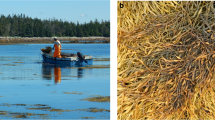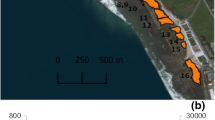Abstract
Commercial exploitation of Ascophyllum nodosum (rockweed) along the coast of Nova Scotia began in the late 1950s when it was used as a raw material for manufacturing alginate and “kelp” meal. Today, this resource is used as a biostimulant extract for crops and animal feed supplements and is the main economic resource of the seaweed industry in the Maritime Provinces and Canada. The management of rockweed, by dividing the resource into many sectors, permitted the assessment of yield per unit area of bed. In Nova Scotia, mechanical harvesting of A. nodosum operated on a pulse of 2- to 3-year schedule providing yields of 21.9 to 47.7 wet t ha−1 averaging 35.3 ± 7.6 wet t ha−1. Acadian Seaplants Limited (ASL) has become the dominant player in the region since 1995 with more than 75% of the total biomass under its leases and more than 90% of the total landing of rockweed in the last 13 years. Sustained harvests at ASL leases and under an annual harvest schedule using hand cutting methods have averaged 17.4 ± 2.6 t ha−1. Exploitation rates above 35% of the harvestable crop lead to a pulse harvest strategy and the need to move infrastructure year after year. In New Brunswick, a new approach to management began in 1995 with a regulated 17% exploitation rate. Thus, the yield in that province is 14.3 wet t ha−1. The current summer standing crop for this region has been calculated at 352,723 wet t, covering an area of 4,960 ha, with an average biomass of 71.3 t ha−1. The harvest in the region reached peak landings in 2010 with just over 40,100 t. The consistent yield per hectare of A. nodosum beds is proof of good management practices and an ecologically sustainable harvest in the Canadian Maritimes.





Similar content being viewed by others
Explore related subjects
Discover the latest articles and news from researchers in related subjects, suggested using machine learning.References
Anderson RJ, Simons EH, Jarman NG (1989) Commercial seaweeds in southern Africa: a review of utilization and research. S Afr J Mar Sci 8:277–299
Anderson RJ, Bolton JJ, Molloy FJ, Rotmann KWG (2003) Commercial seaweed production and research in southern Africa. In: Chapman ARO (ed) Proceedings of the 17th International Seaweed Symposium. Oxford University Press, Oxford, pp 1–12
Ang PO, Sharp GJ, Semple RE (1993) Changes in the population structure of Ascophyllum nodosum (L.) Le Jolis due to mechanical harvesting. Hydrobiologia 261:321–326
Chopin T, Ugarte R (2006) The seaweed resource of Eastern Canada. In: A.T. Critchley AT, Ohno M and Largo DB (eds) World Seaweed Resources: an authoritative reference system: 46 p. A multimedia, interactive DVD-ROM. ETI BioInformatics, Amsterdam. ISBN: 90 75000 80 4
Cousens R (1984) Estimation of annual production by the intertidal brown alga Ascophyllum nodosum (L.) Le Jolis. Bot Mar 27:217–227
Cousens R (1986) Quantitative reproduction and reproductive effort by stands of the brown alga (Ascophyllum nodosum (L.) Le Jolis) in south-eastern Canada. Estuar Coast Shelf Sci 22:495–507
Rangeley RW, Kramer DL (1998) Density-dependent antipredator tactics and habitat selection in juvenile Pollock. Ecol 79:943–952
Santelices B, Ugarte R (1987) Production of Chilean Gracilaria: problems and perspectives. Hydrobiologia 151/152:295–299
Sharp GJ (1986) Ascophyllum nodosum and its harvesting in Eastern Canada. In: case studies of seven commercial seaweed resources FAO. Tech Rep 281:3–46
Sharp GJ, Bodiguel C (2002) Introducing integrated management, ecosystem and precautionary approaches in seaweed management: the Ascophyllum nodosum (rockweed) harvest in New Brunswick Canada and implications for industry. In: Chapman ARO (ed) Proceedings of the 17th International Seaweed Symposium. Oxford University Press, Oxford, pp 107–114
Sharp GJ, Tremblay D (1989) An assessment of Ascophyllum nodosum resources in Scotia Fundy. CAFSAC Res Doc 89(1):13
Sharp GJ, Ang P Jr, MacKinnon D (1994) Rockweed (Ascophyllum nodosum (L.) Le Jolis harvesting in Nova Scotia: its socioeconomic and biological implications for coastal zone management. Proc Coastal Zone Canada 94:1632–1644
Ugarte R (2011) An evaluation of the mortality of the brown seaweed Ascophyllum nodosum (L.) Le Jol. produced by cutter rake harvests in southern New Brunswick, Canada. J Appl Phycol 23:401–407
Ugarte R, Sharp GJ (2001) A new approach to seaweed management in eastern Canada: the case of Ascophyllum nodosum. Cah Biol Mar 42:63–70
Ugarte R, Sharp GJ, Moore B (2006) Changes in the brown seaweed Ascophyllum nodosum (L.) Le Jol., plant morphology and biomass produced by cutter rake harvests in southern New Brunswick, Canada. J Appl Phycol 18:351–359
Ugarte R, Craigie JS, Critchley AT (2010) Fucoid flora of the rocky intertidal of the Canadian Maritimes: implications for the future with rapid climate change. In: Israel A, Einav R, Seckbach J (eds) Seaweeds and their roles in globally changing environments. Springer, Heidelberg, pp 69–92
Vásquez JA (2008) Production, use and fate of Chilean brown seaweeds: resources for a sustainable fishery. J Appl Phycol 20:457–467
Vásquez JA, Piaget N (2011) Management and sustainability of Chilean brown seaweed fishery. Proceeding of 4th Congress of the International Society for Applied Phycology, 19–24 June 2011, Halifax, Canada, 39
Vea J, Ask E (2011) Creating a sustainable commercial harvest of Laminaria hyperborean, in Norway. J Appl Phycol 23:489–494
Author information
Authors and Affiliations
Corresponding author
Rights and permissions
About this article
Cite this article
Ugarte, R., Sharp, G. Management and production of the brown algae Ascophyllum nodosum in the Canadian maritimes. J Appl Phycol 24, 409–416 (2012). https://doi.org/10.1007/s10811-011-9753-5
Received:
Revised:
Accepted:
Published:
Issue Date:
DOI: https://doi.org/10.1007/s10811-011-9753-5




